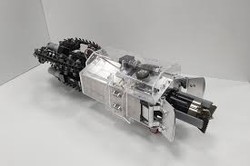
A research team led by Professor Hyun Myung from the School of Electrical Engineering has developed a drilling biomimetic robot called the “Mole-bot”. Measuring 26 centimeters wide and 84 centimeters long and weighing 26 kilograms, Mole-bot can excavate three times faster than conventional models, and with directional accuracy six times higher.
Mole-bot drew inspiration from the features of mole-rats. The robot’s expandable drill mimics the chiseling ability of the African mole-rat’s front teeth, which can exert force with a magnitude of 48 times its body weight. After excavating, the robot removes soil and debris using its forelimbs, which have embedded muscle features resembling that of the European mole rat’s scapula. The robot’s elongated waist can rotate 360 degrees, making it suitable for directional drilling. Furthermore, the new sensor systems and algorithms the research team developed and applied enable 3D autonomous underground navigation based on the 3D Simultaneous Localization and Mapping (SLAM) technology, which matches the Earth’s magnetic sequence.
According to Professor Myung, “Mole-bot will have a very positive impact on the robotics market in terms of its extensive application spectra and economic feasibility.” Mole-bot not only reduces cost and labor because it does not require extra equipment, but it also minimizes environmental damage as it does not use mud compounds for cleaning debris.
The drilling market is projected to grow by 103 million USD in 2021, according to a survey by a revenue impact report company. The growth, spurred by the Shale Revolution, will expand further with the emerging market for space and polar resources. Mole-bot, which is expected to be utilized for space exploration and mining valuable underground resources such as coalbed methane and Rare Earth Elements (REE), is a huge step towards efficient underground drilling and exploration technologies.

